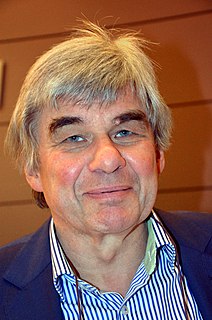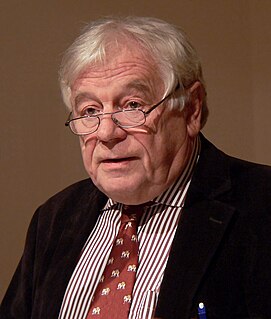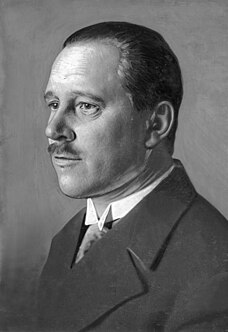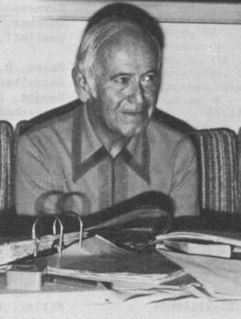Antisemitism is hostility to, prejudice towards, or discrimination against Jews. A person who holds such positions is called an antisemite. Antisemitism is considered to be a form of racism.

Alfred Ernst Rosenberg was a Baltic German Nazi theorist and ideologue. Rosenberg was first introduced to Adolf Hitler by Dietrich Eckart and he held several important posts in the Nazi government. He was the head of the NSDAP Office of Foreign Affairs during the entire rule of Nazi Germany (1933–1945), and led Amt Rosenberg, an official Nazi body for cultural policy and surveillance, between 1934 and 1945. During World War II, Rosenberg was the head of the Reich Ministry for the Occupied Eastern Territories (1941–1945). After the war, he was convicted of crimes against peace; planning, initiating and waging wars of aggression; war crimes; and crimes against humanity at the Nuremberg trials in 1946. He was sentenced to death and executed on 16 October 1946.

Holocaust denial is a form of genocide denial drawing on antisemitic conspiracy theories that asserts that the Nazi genocide of Jews, known as the Holocaust, is a myth or fabrication. Holocaust deniers make one or more of the following false statements:

German Christians was a pressure group and a movement within the German Evangelical Church that existed between 1932 and 1945, aligned towards the antisemitic, racist and Führerprinzip ideological principles of Nazism with the goal to align German Protestantism as a whole towards those principles. Their advocacy of these principles led to a schism within 23 of the initially 28 regional church bodies (Landeskirchen) in Germany and the attendant foundation of the opposing Confessing Church in 1934.

The propaganda used by the German Nazi Party in the years leading up to and during Adolf Hitler's dictatorship of Germany from 1933 to 1945 was a crucial instrument for acquiring and maintaining power, and for the implementation of Nazi policies.
The Jewish question, also referred to as the Jewish problem, was a wide-ranging debate in 19th- and 20th-century European society that pertained to the appropriate status and treatment of Jews. The debate, which was similar to other "national questions", dealt with the civil, legal, national, and political status of Jews as a minority within society, particularly in Europe during the 18th, 19th, and 20th centuries.

Matthias Küntzel, is a German author and a political scientist. He is a research associate at the Hebrew University of Jerusalem, a member of the German Council on Foreign Relations DGAP, of the German Historical Association (VHD) and of the Association for the Study of the Middle East and Africa ASMEA.
Monsignor John Maria Oesterreicher, born Johannes Oesterreicher, was a Catholic theologian and a leading advocate of Jewish–Catholic reconciliation. He was one of the architects of Nostra aetate or "In Our Age," a declaration which was issued by the Second Vatican Council in 1965 and which repudiated antisemitism.

Gerhard Kittel was a German Lutheran theologian and lexicographer of biblical languages. He was an enthusiastic supporter of the Nazis and an open antisemite. He is known in the field of biblical studies for his Theologisches Wörterbuch zum Neuen Testament.
Walter Frank, also known by the pseudonym Werner Fiedler was a Nazi historian, notable for his leading role in anti-Semitic research.

The Nisko Plan was an operation to deport Jews to the Lublin District of the General Governorate of occupied Poland in 1939. Organized by Nazi Germany, the plan was cancelled in early 1940.
Walter Grundmann was a German Protestant theologian and antisemitic Nazi and Stasi collaborateur during the Third Reich and GDR. Grundmann served both German dictatorships. He was a member of the Nazi party from 1930 onwards, and from 1933 onwards an active member of the German Christians and prospered as a state-antisemitism supporting theologian and professor for ethnic theology. In 1939, he was made head of the newly founded Instituts zur Erforschung jüdischen Einflusses auf das deutsche kirchliche Leben in Jena, which was meant to serve state antisemitism by the "Entjudung" (dejudifying) of the Bible and giving antisemitic theological training and arguments for Nazi propaganda. Despite his past Nazi activities, Grundmann regained some prestige as an evangelic theologian in East Germany; in 1959 he published his comments on the Gospels, which by the 1980s had become standard popular literature. However, Grundmann also prospered as a "Secret Informer" to the Ministry for State Security ("Stasi"). He spied on theologians in Eastern and Western Germany. His cover name was GM Berg after the Sermon on the Mount ("Bergrede") to which he referred in his inaugural speech 1939 at the Institute for the Study and Elimination of Jewish Influence on German Church Life, set up under him in Jena.
Secondary antisemitism is a distinct form of antisemitism which is said to have appeared after the end of World War II. Secondary antisemitism is often explained as being caused by the Holocaust, as opposed to existing in spite of it. One frequently quoted formulation of the concept, first published in Henryk M. Broder's 1986 book Der Ewige Antisemit, stems from the Israeli psychiatrist Zvi Rex, who once remarked: "The Germans will never forgive the Jews for Auschwitz." The term was coined by Peter Schönbach, a Frankfurt School co-worker of Theodor W. Adorno and Max Horkheimer, based on their critical theory.

Wolfgang Benz is a German historian from Ellwangen. He was the director of the Center for Research on Antisemitism of the Technische Universität Berlin between 1990 and 2011.

Karl Alexander von Müller was a German historian. His immediate disciples were Nazi politicians and academics such as Baldur von Schirach, Rudolf Heß, Hermann Göring, Walter Frank, Wilhelm Grau, Wilfried Euler, Clemens August Hoberg, Hermann Kellenbenz, Karl Richard Ganzer, Ernst Hanfstaengl and Klaus Schickert. However, due to his political openness, other non-Nazi historians such as Karl Bosl, Alois Hundhammer, Heinz Gollwitzer and even Wolfgang Hallgarten also studied under Müller.

Dr. Richard Korherr was a professional statistician in Nazi Germany, and chief inspector of the statistical bureau of the SS during World War II. Korherr eventually held the rank of SS-Sturmbannführer.
Kurt von Behr headed the Nazi art looting organisation, Einsatzstab Reichsleiter Rosenberg (ERR), in Paris and was involved in the M-Action which looted the home furnishings of French Jews.
Institute for the Study of the Jewish Question was a German institute under Goebbels founded in 1934.
The Institute for the Study of the Jewish Question was founded in 1934 and was affiliated with the Reich Ministry of Propaganda under Joseph Goebbels. In 1939 the institution was called "Anti-Semitic Action" and from 1942 "Anti-Jewish Action".
The M-Aktion, was a Nazi looting organisation. Attached to the "Einsatzstab Reichsleiter Rosenberg", starting in early 1942 the M-Aktion looted approximately 70,000 homes of French, Belgian, and Dutch Jews who had either fled or had been deported.










